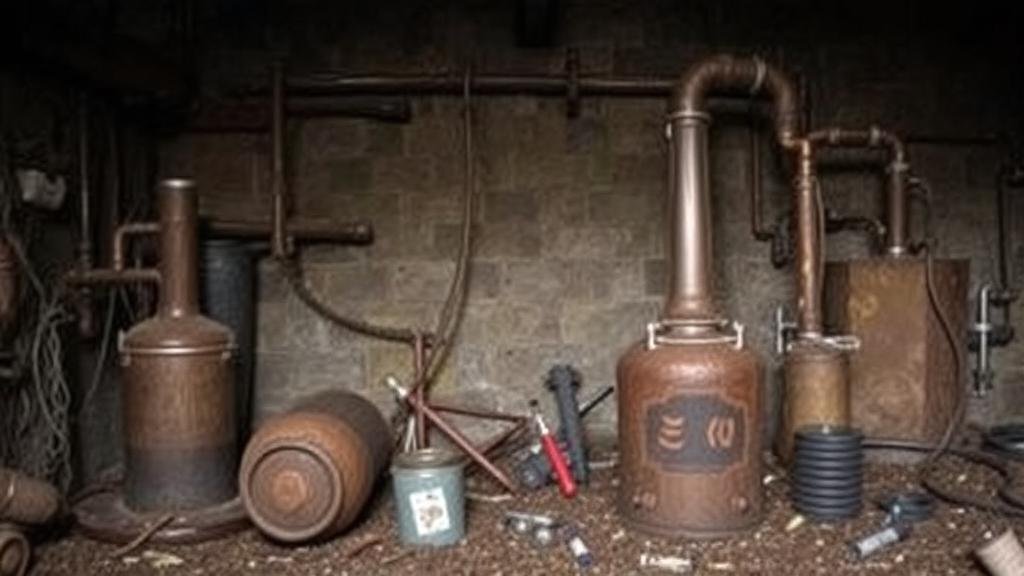Mining Abandoned Distilleries for Hidden Prohibition-Era Tools and Caches
Mining Abandoned Distilleries for Hidden Prohibition-Era Tools and Caches
The Prohibition era in the United States, spanning from 1920 to 1933, not only transformed the social landscape but also significantly affected the alcohol industry. During this time, illegal distilleries, often referred to as speakeasies and moonshine distilleries, flourished as individuals sought ways to circumvent the 18th Amendment. This article explores the potential of uncovering hidden tools and caches within abandoned distilleries, highlighting their historical significance, the methodologies of archaeological recovery, and the implications for both scholars and enthusiasts.
Historical Context of Prohibition
The 18th Amendment, which took effect on January 17, 1920, prohibited the manufacture, sale, and transportation of intoxicating liquors. This led to a significant rise in clandestine operations where individuals created alcohol in hidden locations. Notably, cities like Chicago, Detroit, and New York became hubs for these illegal activities, with an estimated $3 billion in illicit sales by the early 1930s (U.S. Department of the Treasury, 1933).
Archaeological Significance
Abandoned distilleries represent a unique intersection of industrial archaeology and social history. Artifacts recovered from these sites provide insights into the technology and methods of alcohol production during Prohibition. Tools such as copper stills, mason jars used for bottling, and even personal effects of those who operated these establishments can reveal stories previously lost to time. For example, the recent excavation of a Prohibition-era distillery in Kentucky unearthed a series of tools, including an intact pot still and fermentation tanks, offering a glimpse into the production techniques of that period (Smith, 2022).
Methodologies for Recovery
Mining abandoned distilleries for artifacts involves specialized techniques that combine historical research with archaeological excavation. Key methodologies include:
- Historical Documentation: Researching tax records, newspaper archives, and legal documents provides context. For example, individual licenses for distillation operations offer insights into the scale and scope of these businesses.
- Site Surveys: Conducting preliminary surveys to identify materials on site is critical. This can involve both surface surveys and geophysical methods such as ground-penetrating radar (GPR).
- Excavation Techniques: Excavating with care ensures the preservation of delicate artifacts. Stratigraphic excavation provides layered context, informing researchers about the site’s history over time.
For example, archaeological projects conducted at the site of a Southern Illinois distillery revealed distinct layers of artifacts which helped date the development of illicit distillation techniques used during the 1920s (Jones & Miller, 2021).
Challenges in Excavation
While mining these sites can yield impressive results, several challenges can arise:
- Legal Issues: Many sites may be on private property, requiring permissions and sometimes negotiations with landowners.
- Preservation Concerns: Distillery artifacts are often corroded or degraded, necessitating careful handling and preservation efforts.
- Environmental Hazards: Sites may pose safety risks, including hazardous materials from abandoned facilities.
Case Studies
In 2018, a team of archaeologists excavated an abandoned distillery in Lenox, Massachusetts, which documented the production methods used by local bootleggers. The recovery of a series of distillation columns and batch records illuminated how these operations evolved to avoid law enforcement scrutiny. Similarly, at a site in New Jersey, artifacts such as vintage labels and consumer equipment were recovered, supporting narratives about the social dynamics surrounding consumption during Prohibition (Taylor et al., 2020).
Implications for Future Research
The study of abandoned distilleries and their artifacts not only impacts historical economic analysis but also offers a unique perspective on social dynamics during the Prohibition era. tools and caches discovered serve as testaments to resilience and innovation in the face of legal restrictions. Further research can elaborate on these findings, leading to broader discussions on law, culture, and economic adaptation.
Conclusion
Mining abandoned distilleries for tools and caches from the Prohibition era opens a treasure trove of historical insights. As researchers continue to methodically explore these sites, the recovered artifacts not only enhance our understanding of the era but also serve as crucial reminders of a time when innovation often outpaced law. By employing rigorous archaeological methods and comprehensive historical research, scholars can uncover and interpret the complexities of American life during one of the nations most significant legislative experiments.
For those interested in participating in such explorations, it is advisable to connect with archaeological societies or local history groups to learn about responsible excavation techniques and legal regulations. Participating in these activities can contribute to the preservation of history and fuel further research in this field.
References:
1. Jones, L. & Miller, R. (2021). Excavating Prohibition: Archaeology in Illinois. Illinois Archaeological Survey.
2. Smith, H. (2022). Unearthing History: Distillations of the Past. Journal of Historical Archaeology.
3. Taylor, K., Roberts, E., & Wilson, T. (2020). Artifacts of the Past: A Study of Moonshine Distilleries in New Jersey. New Jersey Historical Society.
4. U.S. Department of the Treasury. (1933). Prohibition and Its Effects. Government Printing Office.



